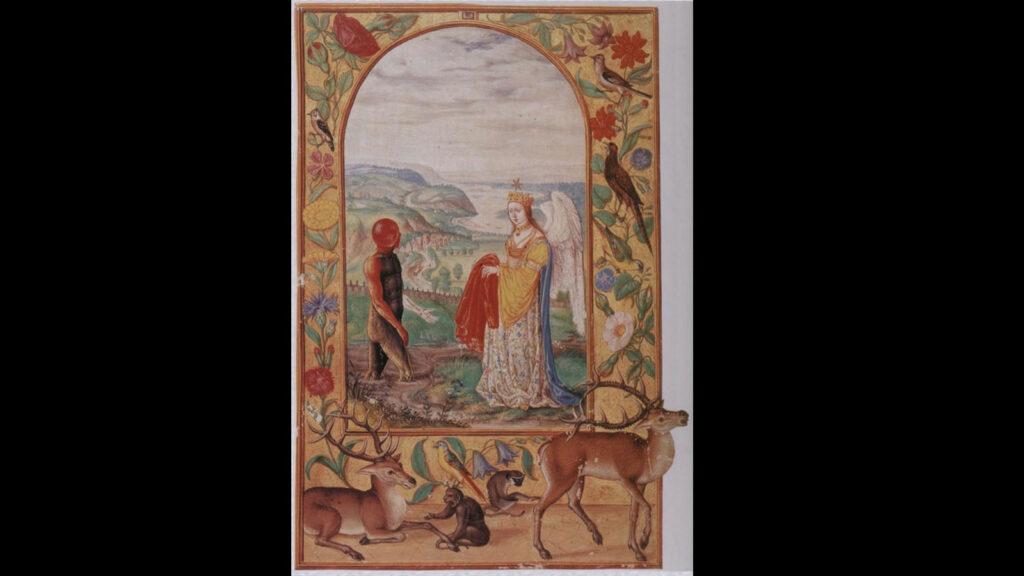The Splendor Solis is the remarkable and exquisite examples of alchemical manuscripts. The article below is a very detailed Jungian amplification of each of the images. If nothing else, click on the link here or at the bottom of the article from the Archive for Archetypal Symbolism and just look at the pictures.
Joseph Henderson, on The Splendor Solis

“This picture is called The Regeneration of the Ethiopian…. The Ethiopian is a figure that appears often in alchemy and it represents a new and more essential problem pertaining to the nigredo or blackness… Here, the feminine principle rescues the masculine principle from contamination by the inferior function. It seems to me, that this is a metaphor for the appearance of that which has never been cultivated and yet seems to represent the greatest potential for growth – something that has to be redeemed from the unconscious and yet is much more profound than what was represented by the old king in the previous painting.
from the article by Benviniste and Henderson
ON THE SPLENDOR SOLIS:
A SUMMARY OF JOSEPH L. HENDERSON’S PRESENTATION ENTITLED “THE SPLENDOR SOLIS.”
Daniel Benveniste in collaboration with Joseph L. Henderson, M.D.
Dr. Henderson presented the first San Francisco Friends of ARAS lecture on December 7, 1985. His topic was a psychological commentary on a series of paintings from an alchemical text entitled “The Splendor Solis”. Subsequently, in 1987, Dr. Henderson presented his material for a smaller gathering and a video production team. The video of this lecture was presented to the Friends of ARAS on May 22, 1988. The following summary is based on my own notes as well as material from both presentations available in the Virginia Allan Detloff Library at the C.G. Jung Institute of San Francisco.
“The Splendor Solis: Alchemical Treatises of Solomon Trismosin – Adept and Teacher of Paracelsus” is an alchemical text, dated 1582, which now resides in the British Museum. It has 22 beautifully painted illustrations depicting the different stages of transformation in three different series. There is a frontispiece to the whole series followed by the first treatise with 10 images, the second treatise with 7 images and the third treatise with 4 images. Some of these pictures are included in Jung’s “Psychology and Alchemy,” some in Johannes Fabricius’ “Alchemy: The Medieval Alchemists and their Royal Art.” Most of the images are reproduced in color in Alexander Roob’s “Alchemy and Mysticism.” Fortunately, there is a reproduction of the book itself, but the pictures based on the originals are in black and white. Full color slides of the 22 images are available in the ARAS Collection. In addition, Dr. Henderson, with the assistance of Dyane Sherwood, has written a book-length discussion and interpretation of the Splendor Solis, complete with all the images printed in color. Note: This book was completed in 2003, titled “Transformation of the Psyche: The Symbolic Alchemy of the Splendor Solis.”
Dr. Henderson first learned of the “Splendor Solis” in 1937 while still in analysis with Jung. At this time, Jung was deeply interested in alchemy and saw in it a “metaphor of the work we do in Analytical Psychology” (JLH). Thus, the strange alchemical preoccupations of trying to change lead into gold, or the mixing and juggling of mythological material with more recent historical material, or the efforts to bring about chemical transformations, or the strange representations of sex, death, dismemberment, hermaphrodites, royalty, geometric shapes, and so on, suddenly take on new meaning when we recognize them as philosophical play in which the alchemists knowingly (or unknowingly) imbued their chemicals, their laboratories, their diagrams, and their treatises with personal and cultural meaning. This projection of psychology into substance enabled the alchemist to work (play) at the transformation of his depressed mind into an enlightened mind and in metaphor, to transform his lead into gold. The following summary of Dr. Henderson’s presentation includes descriptions of the 22 paintings. These paintings, composed of vivid imagery framed by detailed borders, are too beautiful and too elaborate to be rendered in words so the descriptions will be brief.
Read On the Splendor Solis in its entirety here.
